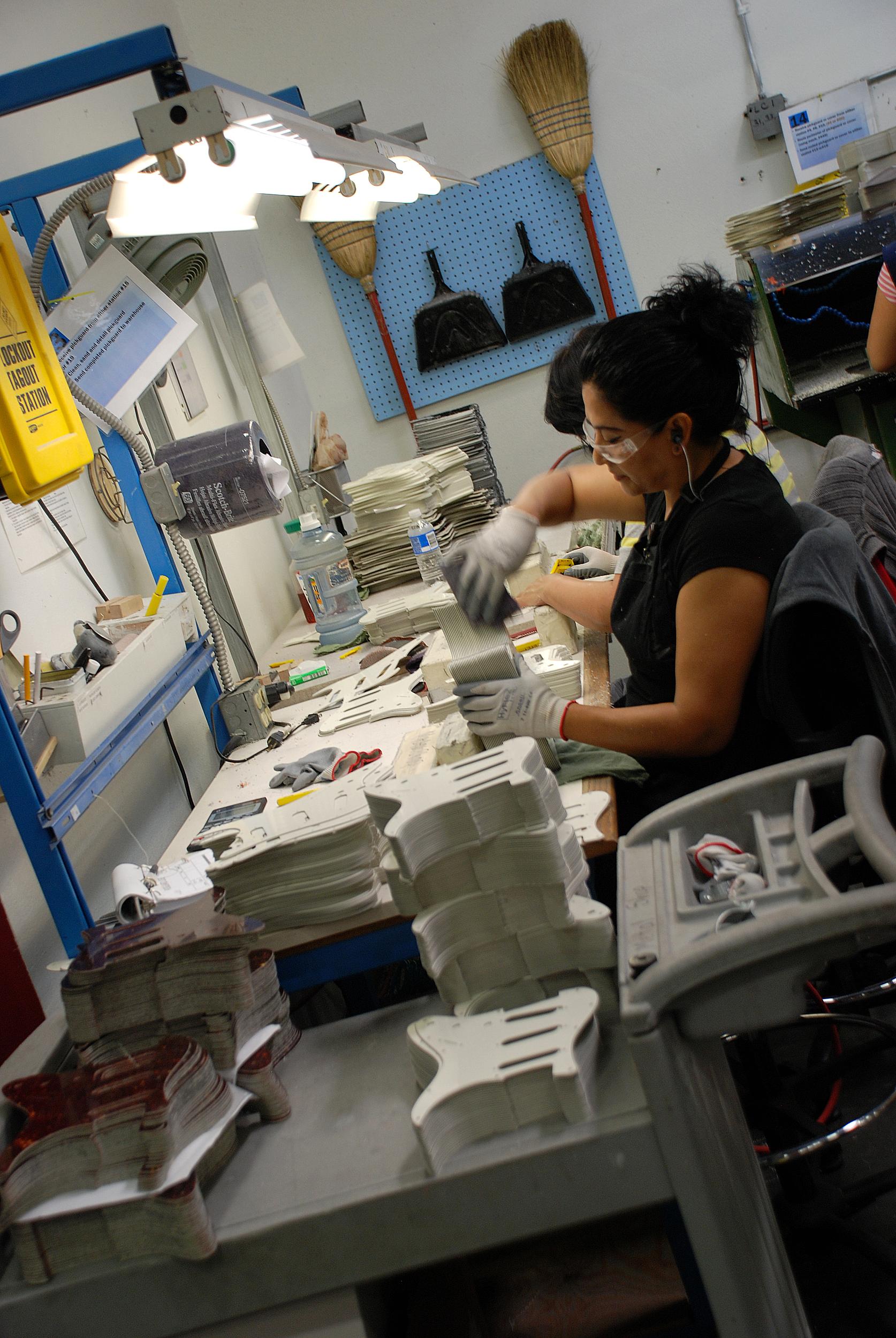Category Archives: Culture
Improving Management Team Performance
 “Ultimately, leadership is not about glorious crowning acts. It’s about keeping your team focused on a goal and motivated to do their best to achieve it, especially when the stakes are high and the consequences really matter. It is about laying the groundwork for others’ success, and then standing back and letting them shine.” —Chris Hadfield
“Ultimately, leadership is not about glorious crowning acts. It’s about keeping your team focused on a goal and motivated to do their best to achieve it, especially when the stakes are high and the consequences really matter. It is about laying the groundwork for others’ success, and then standing back and letting them shine.” —Chris Hadfield
The key to improving management team performance is summarized quite nicely in the Chris Hadfield quote above. When your management team can lay the groundwork for their employees to succeed and then stand back and let them shine, the whole organization performs better. So, what should you be looking at to improve the performance of your management team?
What is their focus?
What are your managers focusing on? It can be easy for them to get caught up in focusing solely on the bottom line and forget about the employees who are contributing to that bottom line. Or, they can become so concerned with gaining recognition for themselves that they forget about the people who are really doing the work. The best management teams focus on the ‘what’ and the ‘who’. When management spends their energy on supporting their employees in determining the ‘how’ for themselves, performance improves at every level of the organization.
How are their relationships?
What kind of relationships are your managers developing? Relationships are built on mutual trust and respect; they cannot thrive in an us vs. them environment. Without strong relationships managers are ineffective. If you want to improve the performance of your management team, help them build strong, trusting, inclusive relationships.
How do they accomplish objectives?
How do your managers accomplish the objectives that you have set for them? Many managers defer to micromanagement as a means for accomplishing tasks and achieving goals. Micromanagement kills employee engagement and does more harm to productivity than good. When you put an end to micromanagement and empower employees to make decisions and take action on their own you greatly improve performance.
As Your Management Team Performs
As your management team performs, so will their employees. Make sure your managers are focusing on the right things. Help them build the relationships that lead to efficiency and top performance. Teach them to empower and support employees in accomplishing objectives rather than micromanaging them. When your management team provides the foundation employees need to succeed and can then stand back and lets employees shine, everyone’s performance improves.
What action will you take today to start improving the performance of your management team?
© 2017 Elizabeth Stincelli
Liz Stincelli is passionate about recognizing and inspiring the leader in each of us. She is the Founder of Stincelli Advisors where she focuses on helping organizations change attitudes, change communication dynamics, improve collaboration and problem-solving, engage employees, and strengthen organizational culture. Liz holds a Doctor of Management degree with an emphasis on organizational leadership.
Learn more about Liz by visiting her website, stincelliadvisors.com and connect with her on Twitter @infinitestin, Google+, and LinkedIn. You can contact her by email at stincelliadvisors@gmail.com.
Culture: Not Merely a Handbook
 “If I can impact an executive and his or her team, I can help to change the culture of an organization.” —Srikumar Rao
“If I can impact an executive and his or her team, I can help to change the culture of an organization.” —Srikumar Rao
Just like you can’t legislate morals, you cannot build culture by policy alone. Culture is far more than just words in a handbook, it is more than some vision painted in the hallway; culture is constantly changing, it adapts with every interaction that takes place. One of your greatest challenges as a leader is to guide the development of your culture. So, if it is not built by policy, what does build culture?
It lives and breathes
Culture is a living, breathing thing; it needs care. If you, as a leader, neglect the culture of your organization it will fail to flourish. It will slowly become toxic with the ability to poison everyone who works with your organization. Conscious care builds culture.
It evolves
Culture is constantly changing. Every act can potentially have an impact on it. Your culture can evolve in ways that benefit employees and customers alike or evolution can lead it down the path to destruction. As a leader, your actions set the example to your employees. And, positive actions build culture.
It is bigger than the sum of its parts
Culture is built out of the relationships, interaction, and the dynamics of the people in the organization. But, culture is much bigger than the sum of its parts. Every member of your team plays an important role in the organization. Valuing the contributions that individuals make to the success of the whole builds culture.
What are You Building?
Culture cannot be written into existence by any policy. Culture lives and breathes; make sure to care for it. Culture is constantly evolving; guide it in a positive direction. Culture is built on the individual relationships and interactions that make up the whole; value every contribution. Your behavior, as a leader, is what builds culture.
© 2017 Elizabeth Stincelli
Liz Stincelli is passionate about recognizing and inspiring the leader in each of us. She is the Founder of Stincelli Advisors where she focuses on helping organizations change attitudes, change communication dynamics, improve collaboration and problem-solving, engage employees, and strengthen organizational culture. Liz holds a Doctor of Management degree with an emphasis on organizational leadership.
Learn more about Liz by visiting her website, stincelliadvisors.com and connect with her on Twitter @infinitestin, Google+, and LinkedIn. You can contact her by email at stincelliadvisors@gmail.com.
Have You Created a Toxic Work Environment?
 “Toxic people defy logic. Some are blissfully unaware of the negative impact that they have on those around them, and others seem to derive satisfaction from creating chaos and pushing other people’s buttons.” —Travis Bradberry
“Toxic people defy logic. Some are blissfully unaware of the negative impact that they have on those around them, and others seem to derive satisfaction from creating chaos and pushing other people’s buttons.” —Travis Bradberry
Is Your Work Environment Toxic?
A toxic work environment is like mold. It often grows hidden, slowly poisoning everyone in the organization. It can spread through your organization, your team, or your department one person at a time or it can sweep through entire segments like a toxic cloud. You can recognize a toxic work environment by a lack of trust, poor communication, negative attitudes, lack of participation in company activities, and a disengaged approach to work. So, where is it coming from?
People
One of the first places to look is to the people in the organization. This includes employees and management alike. As a leader, the tendency is to look for the employees who act like a cancer in the organization, spreading a negative attitude. But, sometimes the culprit is staring at you from across the table in an executive meeting or, quite possibly, looking back at you in the mirror every morning. Is there a toxic attitude or form of power hiding in your organization?
Structure
The management structure of your organization is another hiding place for toxicity. Structures that place too much power in the hands of few individuals lend themselves to micromanagement. Micromanagement is one of the most poisonous behaviors in an organization. Structures that support micromanagement, whether intentional or unintentional, breed a hostile work environment where no one wins.
Communication
Shhh, stop and listen. What do you hear? Is there silence, a clear sign that no one is sharing any information? Is there negative murmur, putting disengagement and poor attitudes on display for everyone else to witness? Communication is one of the first things to breakdown as your environment turns toxic. Poor communication turns into cycle of negativity that feeds on itself as your environment spins in a downward spiral.
Culture
What is the first feeling employees experience when they walk in the door each morning? Is it fear? Dread? Boredom? Your culture permeates the energy that employees encounter from the moment they walk through the door until, often, long after they leave for the day. If positive energy is not purposefully created by management, there is a good chance that your culture will turn toxic, poisoning everyone who comes into contact with it including your customers.
How Do You Stop It?
Undetected, a toxic work environment is deadly. So, how do you stop it? First you have to take your blinders off; no more walking around in denial of the danger. You need to become an encourager of people. Lifting them higher and investing in them so they can become the best they can be. Take a good look at your management structure. Is power placed so heavily that it results in toxic micromanagement? Make sure you are communicating openly and honestly. When employees see you, as a leader, demonstrating positive communication, they will learn to trust you and follow suit. What type of energy fills your halls, offices, conference rooms, and work areas? If you are not deliberately creating the positive energy that results to a great culture, you are part of the problem.
The bottom line is this: it all start or stops with leadership. Open your eyes; is your work environment toxic?
© 2016 Elizabeth Stincelli
Liz Stincelli is passionate about recognizing and inspiring the leader in each of us. She is the CEO of Stincelli Advisors where she focuses on helping organizations engage employees and improve organizational culture. Liz holds a Doctor of Management degree with an emphasis on organizational leadership.
Learn more about Liz by visiting her website, stincelliadvisors.com and connect with her on Twitter @infinitestin, Google+, and LinkedIn. You can contact her by email at stincelliadvisors@gmail.com.
The Changing Work Environment Part III: Providing Choice
 “I believe happiness is a choice. Some days it is a very difficult choice.” – Steve Gleason
“I believe happiness is a choice. Some days it is a very difficult choice.” – Steve Gleason
Our three part series on the changing work environment was inspired by findings in the Staples Advantage Workplace Index (http://bit.ly/1ULVQr7). Findings in the report reveal that half of workers state feeling overworked is motivating them to look for a new job, 62% say wellness programs are a selling point when looking for a new job, but only 35% actually have a wellness program at their current job, 3 out of 4 respondents say their employers don’t give them access to the latest technology to do their job efficiently. You can read more by clicking on the link and reading the full report.
In part III of our series ( In part one we talked about providing flexibility and in part two last week we discussed providing autonomy) on the changing work environment we discuss the importance of providing choice. Employees are not willing to give 100% to a job where they feel trapped. They want opportunity and they want choice.
What does it look like?
In the changing work environment, employees want to know that they have choices. In this new environment management is not dictating ‘how’ everything gets done. Employees are given the ‘what’ and the ‘why’, and then they are given the opportunity to make decisions and design how their work gets done to meet the goals of the company. In addition, they are empowered with the training and resources they need to be successful.
Why is it important?
Employees want to know that they are making a valuable contribution to something bigger than themselves; they want to feel truly invested in their work. When employees have choices, they have a sense of control which shows them that their input is valuable. It tells them they are trusted and are important.
Not long ago Glassdoor published its list of the Best Places to Work 2016 (http://bit.ly/1lN0I2p). Topping the list was Airbnb. An employee review for MindBody (#14) in the Glassdoor article writes, “It’s a culture of happiness! I’ve never been in such a positive environment. Management encourages you not only professionally, but in personal aspects of life too. So thankful to work for such an amazing company!” That sounds to us like a company that understands the value of their employees and wants them to succeed.
How do we do it?
Providing choice requires management to let go of the control they have clung to in the past. Old habits can be hard to break; here are six ACTION steps to help you think through your current operations and to embrace providing choice.
Accountability – The ebb and flow of an organization that provides flexibility, autonomy, and choice hinges on accountability. Regardless of what the organizational structure looks like or how teams are assembled it all comes down to mutual accountability if it is going to succeed.
Collaborate – In this changing work environment collaboration may take on a new look as well. Your box approach to thinking may now look more like a circle that makes room for more people, new ideas, and greater potential. If your workplace environment changes so too must the way you work with others also change.
Train – John Maxwell said, “The people’s capacity to achieve is determined by their leader’s ability to empower.” This is so true in the changing work environment. Training is essential not just for your success today but how you will look and operate five years from now and beyond.
Inspire – What your people need to see as they embrace a new work environment is greater ownership, greater opportunity for growth, and more control over their future. Inspire your people to the possibilities before them and remind them of it often.
Opportunity – The changing workplace environment can be frightening for people who have no voice in the direction they are going or have not bought-in to the vision. If one’s opportunity is not clear to them they will be the last to embrace change. Be vocal, be clear, and be out front with the opportunities that exist and for the ones they will create.
Now – The time for creating this new workplace environment is now. And we would like to remind you of what we advised in part one of this series. Take baby steps and tackle one or two small changes that you can implement right away. Be intentional about your changes and make them gradually. Include your people when charting the course. But get started!
© 2016 Doug Dickerson and Liz Stincelli
Doug Dickerson is an internationally recognized leadership speaker, columnist, and author. He is a contributor for The Las Vegas Tribune, Executive Secretary Magazine, Realizing Leadership magazine, and The Daniel Island News to name a few. Read more at: DougDickerson.WordPress.com
Liz Stincelli is the Founder of Stincelli Advisors where she focuses on helping organizations engage employees and improve organizational culture. She holds a Doctor of Management degree with an emphasis on organizational leadership. Learn more about Liz by visiting her website: www.stincelliadvisors.com
The Changing Work Environment Part II: Providing Autonomy
“The way you delegate is that first you have to hire people that you really have confidence in. You won’t truly let those people feel a sense of autonomy if you don’t have confidence in them.” – Robert Pozen
In part II of our series on the changing work environment we tackle the topic of autonomy. Gone are the days when employees were willing to show up at the factory, follow orders being dictated by management, collect a paycheck, and then do it all again tomorrow. Employees aren’t mindless machines and they don’t want to be treated as such.
What does it look like?
In the changing work environment, employees are demanding more autonomy. In this new environment, employees have control over how their own work tasks get accomplished. They are trusted and encouraged to make decisions and to act in the best interest of the organization without being micromanaged.
Why is it important?
Providing autonomy shows employees that you have confidence in their judgment and ability. This inspires employees to take ownership of their work. When employees have control over their own work they are more satisfied, they take pride in the contribution, and they become loyally invested in the success of their team, department, and organization.
How do we do it?
Many management teams struggle to let go of the control they have become accustomed to for all of these years. Old ways and mindsets can be hard to overcome. Here are six ACTION steps to help you think through your current operations and to embrace autonomy.
Acknowledge the challenge of autonomy. It is critical here to understand the difference between the autonomy of the work while remaining true to the mission and vision of the organization. The two are not in competition but, when done right, are a compliment to one another.
Coalesce around the best ideas for autonomy. The mistake leaders make is believing that their idea of how it looks should prevail. But, as one company leader explained it, “The one who sweeps the floor picks the broom.” How autonomy looks in your organization should be determined by those closest to the work.
Tweak along the way. Ideas that look good on paper may not play out well in reality. Don’t be afraid to go back to the drawing board as you flesh out what is and is not working for you. There is no “one size fits all” approach for how autonomy works. The key here is to be flexible and be willing to make adjustments as needed.
Invest in their success. Greater autonomy in the workplace is reinforced by leaders who have the backs of their people by empowering them and setting them up for success. Invest in your people. Put the tools and resources in their hands they need to succeed. The greater the investment, the greater the autonomy. Be generous.
Ownership is a requirement. Embracing the autonomous workplace is great. But now comes the buy-in that makes it all work. Ownership, like loyalty, is a two-way street. In this model ownership is shared, trust is mutual, expectations are clear, and outcomes are measured. It’s an “all-in” attitude that if not fully subscribed to will derail all efforts of a truly autonomous workplace. Without ownership there is no autonomy.
Next Step – In order to attract and retain the best talent, your organization must offer a level of autonomy. You must provide your employees with the training and resources they need to be successful and then you must step aside and allow them to do their jobs. Show them that you have confidence in them. But, you can’t stop here. Once you have acknowledged the attitudes that are holding you back; have intentionally created a workplace culture; shown employees that you trust them; have identified incremental changes you can make; and observed the impact of those changes, it’s time to take the next step.
Be on the lookout next week for part III of The Changing Work Environment Series: Providing Choice.
© 2016 Doug Dickerson and Liz Stincelli
Doug Dickerson is an internationally recognized leadership speaker, columnist, and author. He is a contributor for The Las Vegas Tribune, Executive Secretary Magazine, Realizing Leadership magazine, and The Daniel Island News to name a few. Read more at: DougDickerson.WordPress.com
Liz Stincelli is the Founder of Stincelli Advisors where she focuses on helping organizations engage employees and improve organizational culture. She holds a Doctor of Management degree with an emphasis on organizational leadership. Learn more about Liz by visiting her website: www.stincelliadvisors.com
It’s a New Work Environment: How do You Get Results?
 “It used to be presumed that if you weren’t at your desk working, you weren’t working, but we said ‘Why can’t we make a workplace where casual meetings are as important as working at your desk?’ Sometimes that’s where your better creative work happens.” —David Chipperfield
“It used to be presumed that if you weren’t at your desk working, you weren’t working, but we said ‘Why can’t we make a workplace where casual meetings are as important as working at your desk?’ Sometimes that’s where your better creative work happens.” —David Chipperfield
The days of command and control leadership are gone. So are the days of slaving away in a factory for your entire life until retirement. The Millennial generation finds the old way of doing business stifling. Employees are becoming more agile and connected than ever; they want flexibility and autonomy. So, how do you get the results you need to be successful in this new work environment?
Be observant
As a leader, you must keep a finger on the pulse of your work environment. The best way to do this is actual, first person observation. Not observation from some corner office, but out on the floor, in the middle of operations observation. When you are out on the floor you get to know your employees, their wants, and their needs. When you really know what’s going on, you can make the needed adjustments to keep things running smoothly.
Share information
Gone are the days of employees being satisfied with only being provided the information that management deems pertinent to their particular tasks. This generation has grown up being bombarded with information; they want access to all to the data and then to be allowed to sort through it on their own. Start sharing the ‘big picture’ information. Where is the company going? How is it going to get there? What is the market like? What kind of changes can they expect to see? The more informed your employees are the better contribution they can make.
Ask questions
There is no better way to learn what is working, what is not, what people want, what people need, and what people know than by asking. You may actually be surprised at the new knowledge you may gain and the new opportunities that might be brought to your attention if only you were to ask the right questions. I’m not talking about closed door meetings with trusted advisors. Again, I’m talking about out on the floor, employees at every level questioning.
Follow up
If you ask the question and you get an answer, you better make sure you follow up. Lack of follow up sends the message that you have no respect for the needs, wants, or input of your employees. More than ever, it’s important that your employees know they are being heard. When you not only ask the questions, but truly listen to the answers and then follow up, employees will learn to trust you. And, they only really follow those they trust.
Be flexible
A rigid work environment is no longer appealing. Why do you care? Because unless you provide an appealing work environment you will lose your best talent and be unable to attract the caliber of talent needed to compete with organizations where flexibility is embraced. This doesn’t mean you need to allow employees to run helter-skelter; it just means that you allow them to make adjustments so that their work and personal lives can become more integrated.
It’s a New Environment
It’s a new work environment. What worked in the past will not attract and keep good employees in the future. The way you lead is going to have to change. Become observant. Start sharing information. Ask questions. Make sure you follow up. And, learn to be flexible.
This new workforce has a lot to offer. Make sure that you provide the right environment so they are offering it to you and not your competition.
© 2016 Elizabeth Stincelli
Liz Stincelli is passionate about recognizing and inspiring the leader in each of us. She is the Founder of Stincelli Advisors where she focuses on helping organizations engage employees and improve organizational culture. Liz holds a Doctor of Management degree with an emphasis on organizational leadership.
Learn more about Liz by visiting her website, stincelliadvisors.com and connect with her on Twitter @infinitestin, Google+, and LinkedIn. You can contact her by email at stincelliadvisors@gmail.com.
What is the Quality of Your Culture?
 “The role of a creative leader is not to have all the ideas; it’s to create a culture where everyone can have ideas and feel that they’re valued.” —Ken Robinson
“The role of a creative leader is not to have all the ideas; it’s to create a culture where everyone can have ideas and feel that they’re valued.” —Ken Robinson
Your organization has a culture; it may be a culture that has been deliberately developed or it may be one that has grown, unnoticed, from the behaviors of organizational leaders. This culture will either have a positive impact on employees, productivity, and innovation or, it will erode the very foundation that the organization needs to be successful. So, what is the quality of your culture?
Collaboration
One of the most obvious signs of a healthy culture is the willingness and ability of employees at every level of the organization to collaborate. This starts with you; as a leader, you must let employees see that you do not know everything and you need the knowledge and support of others. When they see your willingness to collaborate and your appreciation for the value that is created from collaborative efforts, they will be much more comfortable following your example.
Engagement
Another clear sign of a healthy culture is a high level of engagement by employees in their work. Engagement is about active participation. This is not ‘just going through the motion’ participation, but truly invested in the task at hand participation. This type of engagement is developed by leaders who share their big picture passion with employees. These leaders help every employee understand the incredible value they add to every task they participate in. Then they allow employees to have control over their own work.
Curiosity
One often overlooked sign of a healthy culture is curiosity throughout the organization. Curiosity is what drives innovation. It keeps employees excited about their work and wanting to learn and do more. As a leader, you either encourage curiosity and outside-the-box thinking, or you stifle it with an ‘I don’t pay you to think’ attitude. Challenge employees to be curious, to experiment, and to explore new ideas. Curiosity benefits the employee, you as the leader, and the entire organization.
Support
One of the biggest components of a healthy culture is the support of employees by management. Employees need to know you have their back and their best interest at heart. They need to know that they can trust you, and that you trust and respect them in return. An employee should never feel like they have been left to tread water alone. Make sure every employee knows that you are right there with them.
You are the Key
You are the key. You will either use your leadership to purposefully develop a positive culture, or you will turn a blind eye and it will take on a life of its own. Either way, it’s your leadership behaviors that will determine the quality of your culture. Set the example that fosters collaboration. Share the passion that inspires engagement. Challenge employees to be curios. And, make sure your employees know that you are there to support them. So, what is the quality of your culture?
© 2016 Elizabeth Stincelli
Liz Stincelli is passionate about recognizing and inspiring the leader in each of us. She is the Founder of Stincelli Advisors where she focuses on helping organizations engage employees and improve organizational culture. Liz holds a Doctor of Management degree with an emphasis on organizational leadership.
Learn more about Liz by visiting her website, stincelliadvisors.com and connect with her on Twitter @infinitestin, Google+, and LinkedIn. You can contact her by email at stincelliadvisors@gmail.com.
Four Ways You are Making Your Employees Feel Small
 “Good leaders make people feel that they’re at the very heart of things, not at the periphery.” —Warren Bennis
“Good leaders make people feel that they’re at the very heart of things, not at the periphery.” —Warren Bennis
By Elizabeth Stincelli, DM
Without even realizing it, you may be making your employees feel small. Too many leaders let their ego, pride, and hidden agendas get in the way of doing what is best for the employees they are supposed to be serving. You can’t succeed alone and making employees feel small is one of the quickest ways to disengage and disenfranchise the very people who have the skills and abilities you need. Learn to recognize these four leadership behaviors that make your employees feel small.
Your ego is front and center
Your attitude, as a leader, has a huge impact on your employees. When your ego is front and center, your attitude will belittle employees making them feel small. Your ego screams that you identify yourself with power and superiority. It separates you from your employees rather than building community and cohesion.
You micromanage
Nothing appears to demonstrate a lack of trust more than micromanagement. When employees do not feel you have confidence in their abilities to do their jobs, it makes them feel small. But, if you are micromanaging, chances are it says more about you than it does about your employee’s abilities. One of the most important tasks of a leader is to make sure teams work well together and that employees feel engaged and valued. People need to feel competent and in control of their own work. Micromanagement undermines relationships, trust, engagement, performance, and loyalty.
You focus on their shortcomings
It’s important to employees that their work is significant and that they are making a meaningful contribution. When you focus on the shortcomings of your employees you make them feel that their contributions are not of value and this, in turn, makes them feel small. While it is not beneficial to overlook subpar performance, employees must see that you take as much notice of good performance as you do poor. As a leader, it is your responsibility to help employees overcome their shortcomings, not to continually rub their faces in them.
You have hidden agendas
When employees get the feeling that you are less than transparent and are operating based on hidden agendas, it tells them that you do not trust them enough to include them in the true agenda. This builds a culture of distrust that makes employees feel small. Hidden agendas make employees feel vulnerable and prevent the team from being able to work together toward shared goals. Your agenda should always be a shared agenda; hidden agendas never achieve positive results.
Start Making Employees Feel Valued
If you are ever going to succeed as a leader, you must stop making your employees feel small and start making them feel valued. Keep your ego out of it. Your employees need to see that your leadership is about them, not you. Stop micromanaging. Give you employees the training and support that they need and then let them do their jobs. Stop focusing on their shortcomings. Make sure that you acknowledge their strengths and help them to overcome their weaknesses. And, get rid of the hidden agendas. Develop a shared agenda where every employee is working toward the same goals. Your employees will perform to the level that your behavior tells them they should work at; stop making them feel small!
© 2016 Elizabeth Stincelli
Liz Stincelli is passionate about recognizing and inspiring the leader in each of us. She is the Founder of Stincelli Advisors where she focuses on helping organizations engage employees and improve organizational culture. Liz holds a Doctor of Management degree with an emphasis on organizational leadership.
Learn more about Liz by visiting her website, stincelliadvisors.com and connect with her on Twitter @infinitestin, Google+, and LinkedIn. You can contact her by email at stincelliadvisors@gmail.com.
Are You Creating Supportive Partnerships with Your Employees?
 “It is probably not love that makes the world go around, but rather those mutually supportive alliances through which partners recognize their dependence on each other for the achievement of shared and private goals.” —Fred Allen
“It is probably not love that makes the world go around, but rather those mutually supportive alliances through which partners recognize their dependence on each other for the achievement of shared and private goals.” —Fred Allen
By Elizabeth Stincelli, DM
We can accomplish nothing notable alone. We need, as Fred Allen states in the quote above, to form mutually supportive partnerships. This applies both to our personal and our professional lives. In your organization, as the leader, these partnerships must start with you. You must create an environment where support can thrive. You must show your team that you have trust in their abilities and encourage them to develop trust in each other. You must build strong relationships inspire relationship building in others. You must focus on being of service and teaching others to also be of service.
Culture matters
In order to create supportive partnerships, you must establish a firm foundation that is embedded in the very culture of the organization. This culture must encourage and nourish mutually support partnerships at every level of the organization. Employees must know that they are part of a larger vision, that they matter, and that supporting each other is the secret to success.
Trust your team
Trust is a necessary component of supportive partnerships. One of the best ways you can show your support is to make sure everyone knows that you trust your team. When employees see that you have trust in team members, it gives them confidence in each other and allows them to learn to trust both you and their colleagues.
Build relationships
You can only create supportive partnerships if you truly know those who you should be supporting. You must build relationships with your employees on both a personal and a professional level. In turn, they must understand the importance and benefits of building strong relationships with each other.
Be of service
In order to create supportive partnerships, as a leader, you must set the example for your employees of the importance of being of service. You must provide for the needs of employees and serve as a coach, mentor, and cheerleader. Make sure they have access to the resources that they need. And, provide them with ample opportunity to be of service to others in the organization.
Nurture Supportive Partnerships
We are dependent on others for our individual success and the success of the whole. As the leader, you set the example. Entrench supportive partnerships into the culture of your organization. Develop a web of trust throughout your organization. Encourage the building of strong relationships. Be of service and offer opportunities for employees to serve others. When you, as a leader, nurture the creation of supportive partnerships within your organization you set everyone up for success.
© 2016 Elizabeth Stincelli
Liz Stincelli is passionate about recognizing and inspiring the leader in each of us. She is the Founder of Stincelli Advisors where she focuses on helping organizations engage employees and improve organizational culture. Liz holds a Doctor of Management degree with an emphasis on organizational leadership.
Learn more about Liz by visiting her website, stincelliadvisors.com and connect with her on Twitter @infinitestin, Google+, and LinkedIn. You can contact her by email at stincelliadvisors@gmail.com.

